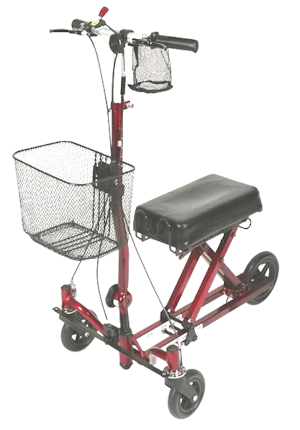Knee Scooters: Types, Functionality, and Buying Tips
Injuries and surgeries can significantly impact mobility, making everyday tasks challenging and even painful. However, advancements in medical devices have introduced innovative alternatives to walkers and crutches, providing greater comfort and mobility during the recovery process.
One such device is the knee scooter, also known as a knee rollator. This article includes helpful information on how knee scooters work, the different types available, and buying tips to help you find the best knee rollator for your specific needs..
How Do Knee Scooters Work?
Knee scooters are designed to provide a safe and convenient means of moving around when weight-bearing on a hurt knee or leg is restricted. The scooters consist of a sturdy frame with a platform to rest your injured leg, handlebars for stability and steering, and wheels for mobility.
By transferring your weight from the affected leg to the knee scooter, you can effortlessly maneuver through various terrains, indoors and outdoors, without compromising your balance.
Types of Knee Scooters in the Market:
- Basic Knee Scooters:
Basic knee scooters feature a simple design with standard features. They are typically affordable and suitable for individuals with temporary injuries or short-term recoveries. These scooters typicallyt offer excellent stability, ergonomic handlebars, and adjustable platforms to accommodate different leg lengths.
- All-Terrain Models:
If you're looking for a knee rollatorr that can tackle various surfaces with ease, an all-terrain model is the ideal choice. These scooters come equipped with larger, rugged wheels and enhanced suspension systems, allowing you to navigate over gravel, grass, or uneven terrains effortlessly..
- Steerable Knee Scooters:
Steerable knee rollators offer the added advantage of increased maneuverability. With a steerable front axle, you can make sharp turns and navigate tight spaces more effectively. These scooters are particularly useful in narrow hallways, crowded areas, or when you need to negotiate obstacles such as furniture or doorways. If agility is a priority, consider investing in a steerable knee scooter.
- Foldable Knee Scooters: For individuals who require a knee rollator on-the-go, foldable models are available. These scooters feature a compact design that can be easily folded and transported in a car trunk or stored in tight spaces. Foldable models often come with quick-release mechanisms for easy assembly and disassembly, ensuring convenience and portability during travel.
Purchasing Tips
- Consult with Your Healthcare Professional: Before purchasing a knee scooter, consult with a qualified medical provider or therapist. He or she can provide valuable guidance regarding the most suitable scooter type and features you need, based on your specific injury or surgery. Your provider may also recommend certain brands or models that have proven to be beneficial for patients.
- Consider Comfort and Adjustability: Comfort is key when using a knee rollator for an extended period. Look for models with comfortable knee pads or cushions that distribute pressure evenly. Additionally, opt for scooters with adjustable handlebars and knee platforms to ensure an optimal fit, minimizing strain on your body.
- Evaluate Weight Capacity and Durability: Ensure that the scooter you choose can support your weight. Different models have varying weight capacities, so be mindful of this aspect when making a purchase. Additionally, consider the durability of the frame and wheels, especially if you intend to use the scooter on rough terrains or for an extended period.
- Test Maneuverability and Stability: If possible, test the knee scooter's maneuverability and stability before buying. Ensure that the turning radius suits your needs, allowing you to navigate tight corners with ease. Assess the stability of the scooter, checking for wobbling or excessive movement that could compromise your balance.
- Research Reviews and Compare Prices: Take the time to read customer reviews and compare prices of different models and manufacturers. Online marketplaces and medical supply stores are great places to start your search. Be sure to consider the overall reputation of the brand, customer feedback, and warranty options when making a decision. Also look into the possibility of renting the knee rollator if you will only be needing it a short time.
Conclusion
Knee scooters offer a practical and comfortable alternative to crutches and walkers during the recovery process. With the various types available, individuals can choose a model that best accommodates their requirements, including size, adjustability, comfort, maneuverability and portability.
Related Information: Knee Scooters
More about Knee Scooters
About Rollators
Selecting Crutches
Walking Canes
Walking Aids: Key Purchase Decisions
Popular ArticlesTypes of Mobility Chairs Wheelchair Sports Activities Helpful Resource Organizations Mobility Scooter Buying Tips Portable Ramp Options |



